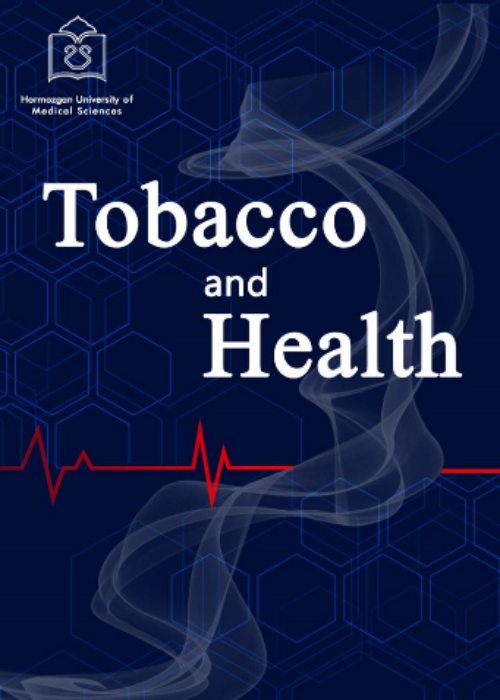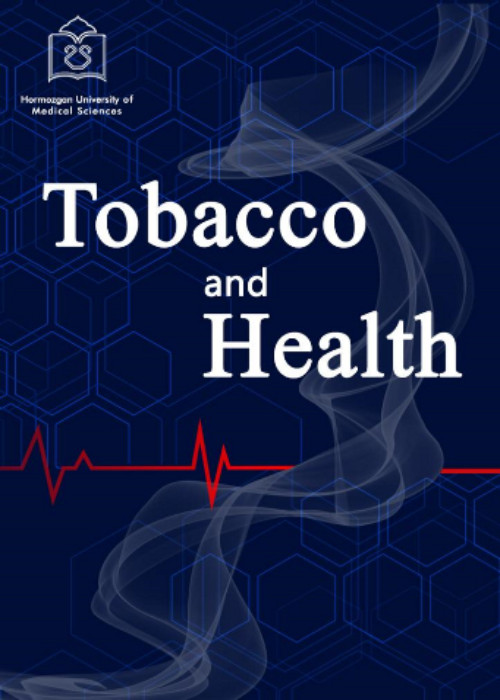فهرست مطالب

Tobacco and Health
Volume:2 Issue: 3, Sep 2023
- تاریخ انتشار: 1402/06/10
- تعداد عناوین: 8
-
Pages 89-92Introduction
Electronic nicotine delivery systems (ENDS), also known as “e-cigarettes” or “vape,” are battery-powered devices made to help smokers quit. Due to their flavors and being less harmful than conventional cigarettes, they have become popular among adolescents and youth. However, the adverse effects of e-cigarettes should also be considered. This review aimed to investigate the relationship between smoking e-cigarettes and experiencing episodes of seizure.
Materials and MethodsThis review is based on research studies found in PubMed, Scholar, Elsevier, and Scopus databases with “electronic nicotine delivery systems”[Mesh] AND “seizures”[Mesh] as keywords. Among the available research, 15 articles were selected as sources for this writing.
ResultsSeizures resulting from the high electrical activity of the brain can be considered a consequence of nicotine toxicity. Inhalation of nicotine increases nicotine levels in plasma. Subsequently, nicotine binds to nicotinic acetylcholine receptors (nAChRs) in different body parts. These areas include brain parts associated with seizures and neuronal excitability, where these receptors are highly expressed, and their activation can also lead to seizures.
ConclusionAlthough the long-term side effects of e-cigarettes are not fully understood, acute health problems, especially seizures, are now a matter of concern. Seizures might happen possibly due to nicotine toxicity, but the causal relationship between using e-cigarettes and seizures is not yet established and needs more information.
Keywords: Electronic nicotine delivery systems, Vaping, Seizure, Adolescence -
Pages 93-100Background
Tobacco use has remained a significant public health challenge worldwide due to its strong association with various cancers. One of the little-known factors contributing to tobacco-related cancers is the presence of naturally occurring radioactive substances in tobacco leaves. These naturally occurring radionuclides, such as radium-226, actinium-228, bismuth-214, and radium-228, originate from soil and fertilizers used in tobacco growing.
Materials and MethodsIn this review study, articles were collected from Medline, PubMed, Scopus, and Google Scholar search engines using keywords: “natural radioactivity,” “tobacco,” “cancer development,” “cigarette,” “smoking,” “cancer,” “carcinogenesis,” “radioresistance,” and “radiotherapy.” Articles were searched without a time limit. The inclusion criteria were articles written in English and having full-text availability.
ResultsThe studies demonstrate a strong correlation between smoking and side effects of cancer treatment. These effects are not limited to specific cancer types but have been observed across various malignancies and therapies.
ConclusionThe carcinogenic mechanism of tobacco is very diverse and complex, involving both chemical and radiobiological factors. Understanding these mechanisms can help develop sensitive methods to identify signature carcinogens in tobacco, facilitating effective and targeted epidemiological studies.
Keywords: Natural radioactivity, Tobacco smoking, Cancer development, Radio resistance, Radiotherapy -
Pages 101-105
Nicotine constitutes the main addictive component of tobacco products. Unfortunately, this compound accounts for millions of deaths and diseases worldwide. Nicotine addiction is a complex phenomenon with multiple biological, psychological, and social factors. One of the challenges in treating nicotine addiction relates to its high rate of relapse, often triggered by exposure to nicotine or smoking cues. Nicotine vaccines, a novel immunological approach, serve to prevent or reduce nicotine addiction. They induce the production of antibodies that bind to nicotine and block its entry into the brain. Nicotine vaccines have shown promising results in preclinical studies but have failed to demonstrate sufficient efficacy and safety in human trials. Several factors may contribute to the limited success of nicotine vaccines: Different antibody responses, genetic and environmental factors, the complexity of nicotine pharmacokinetics and pharmacodynamics, and the heterogeneity of smoking behavior and motivation. This study reviews the rationale, mechanism, development, preclinical studies, and clinical trials of nicotine vaccines, as well as the challenges and future directions of this research field. We believe future research should focus on improving the design and delivery of nicotine vaccines, identifying biomarkers and predictors of antibody responses and treatment outcomes, exploring the combination of nicotine vaccines with other pharmacological and behavioral interventions, and evaluating nicotine vaccines’ long-term effects and cost-effectiveness.
Keywords: Nicotine addictions, Vaccines, Immunotherapy, Antibodies, Smoking cessation -
Pages 107-116Background
Hookah smoking has become prevalent, especially among the Iranian population. Knowing the associated factors is essential in designing preventive interventions. This systematic review was conducted to consolidate the factors linked to hookah smoking in the Iranian people.
Materials and MethodsThis study searched 3 Iranian databases—Magiran, SID, and IranMedex—for articles in Persian and 4 international databases—Scopus, PubMed, Web of Science, and Google Scholar, for articles in English. The search spanned from April 23, 2023, using the keywords “waterpipe,” “hookah,” “goza,” “shisha,” “hubble bubble,” “narghile or smoking,” and “predictive factors or predictors.” This review followed the PRISMA (the preferred reporting items for systematic reviews and meta-analyses) framework.
ResultsThe review included 16 studies (7 English papers and 8 Persian articles). Based on these studies, positive attitudes towards hookah smoking, subjective norms, self-efficacy, perceived threat, socializing with friends, passing leisure time, entertainment, unemployment, pleasant feeling, reducing anxiety and fatigue, and easy access to hookah were related to hookah smoking.
ConclusionThe synthesized evidence from this systematic review highlights the influence of social, cultural, and contextual factors, such as unemployment, anxiety, fatigue, and easy access, on hookah smoking in Iran. Incorporating the above factors in designing and implementing public health interventions might effectively deter hookah use among Iranians.
Keywords: Hookah smoking, Predictive factors, Iranian population -
Pages 117-127Background
A review of the tobacco control initiatives indicates that the evolution of tobacco control and public health into complex interconnected systems requires approaches and methodologies based on the dynamic nature of this environment. This study attempts to view tobacco control policies from the perspective of systemic dynamics.
Materials and MethodsThe research methodology is based on the stages of system dynamics.
ResultsThrough the model’s analysis, two primary smoking control policies are proposed: First, a strategy focused on reducing consumption through enhanced awareness and ongoing monitoring via an active learning program, and second, enhancing the smoking cessation rate by establishing dedicated clinics and utilizing cultural approaches that condemn smoking.
ConclusionUsing either a system dynamics approach or qualitative and descriptive methods, tobacco studies reveal no quantitative decision support system to measure the effectiveness of the policies guiding the development of this system. This gap inhibits the identification of the root cause of the problem and improves the behavior of essential variables with dynamic hypotheses. A fundamental issue in the development of any model is access to valuable and accurate data, a resource not readily and transparently available in Iran.
Keywords: Systems dynamics, Control policies, Tobacco -
Investigating the Microbial Contamination of Unpackaged Cigarettes (Bulk) in Bandar Abbas City, IranPages 129-133Background
Cigarette contamination due to contact with contaminated hands is one of the problems of bulk cigarette distribution. This study was conducted to investigate the microbial contamination of unpackaged cigarettes in Bandar Abbas City, Iran.
Materials and MethodsThis study was conducted among various distributors of bulk cigarettes (peddlers, stalls, and supermarkets) in Bandar Abbas City. Cigarette samples were dried, and the microbial quality of their filter was evaluated by Ultersnap U microbial load measuring device. To express the index of microbial contamination, based on the defined scale of the device, RLUs (relative light units) ≤10 indicate cleanliness, 11 to 29 denote the warning level, and ≥30 signify contamination.
ResultsOur results showed that 26.9% of cigarettes were sold by vendors, 65.4% by stalls, and 7.7% by supermarkets. The prevalence rates of microbial contamination in standard packaged and unpackaged (bulk) cigarettes were 2.3% and 46.2%, respectively. Among the examined samples, 17.3% were clean, 36.5% were contaminated at the warning level, and 46.2% were contaminated. The percentages of contaminated cigarettes sold by vendors, stalls, and supermarkets were 50%, 47.1%, and 25%, respectively.
ConclusionThe results of this study underscore microbial contamination as another side risk that can be transferred directly from the hands of the supplier to the mouth of the consumer. The intensity of contamination was different based on the place of supply (sales units). Therefore, more attention should be paid to the organization of distribution units of these products.
Keywords: Microbial contamination, Unpackaged cigarettes, Tobacco, Bandar Abbas -
Pages 135-141Introduction
Cigarette smoking, quite common among medical students, may downgrade their academic performance. Additionally, initiation of smoking at an early age can increase the likelihood of developing nicotine addiction. This study aims to identify the contributing factors to smoking prevalence and nicotine dependence among medical students in East Azerbaijan Province, Iran.
Materials and MethodsThis cross-sectional study collected data after obtaining participants’ consent and receiving the code of ethics. A checklist was used to meet the inclusion and exclusion criteria. Subsequently, the information was entered into SPSS software and analyzed.
ResultsOut of the 334 individuals who participated in the research, 150(44.9%) were male, and 58(17.4%) were smokers. Significant correlations were observed between smoking, gender, and educational level. The level of nicotine dependence was categorized as very low in 10 individuals (3%), low in 8(2.4%), moderate in 15(4.5%), high in 16(4.8%), and very high in 9(2.7%). Significant relationships were found between nicotine dependence in medical students and their gender and educational level.
ConclusionThere is a relatively high rate of cigarette smoking among medical students, strongly associated with male gender and educational level. As a result, collaborative planning across departments seems necessary to implement preventative, advisory, and therapeutic measures at the societal and university levels.
Keywords: Addiction, Medical students, Prevalence, Smoking, Tobacco use disorder -
Pages 143-154Background
With the rising prevalence of smoking among university students, coupled with the efficacy of the theory of planned behavior (TPB) in smoking prevention, the current study was conducted to assess the effect of education based on the said theory on adopting smoking preventive behaviors among female university students.
Materials and MethodsThis experimental interventional study, conducted in 2018, involved 114 female students of Islamic Azad University, Tonekabon Branch (intervention and control groups, each with 57 students). The study data were collected using a demographic questionnaire and the YRBSS 2013, Fishbein, and Ajzen international questionnaire, focusing on the TPB components (intent, attitude, subjective norms, and perceived behavioral control). The data collection occurred in two stages: Before and one month after the intervention. The educational intervention was delivered in three sessions featuring lectures and group discussion methods. The collected data were analyzed by relevant tests using SPSS software, version 21.
ResultsBefore the intervention, no significant relationships were observed between preventive behavior measures and the TPB components in the experimental and control groups (P <0.05). However, one month after the intervention, there was a statistically significant increase in the experimental group’s mean scores of all TPB components and preventive behaviors (P<0.05).
ConclusionRegarding the effectiveness of education based on the theory of planned behavior in reducing the intent to smoke among female students, using this intervention seems to be an appropriate preventive strategy.
Keywords: Education, Theory of planned behavior, Smoking, Students


